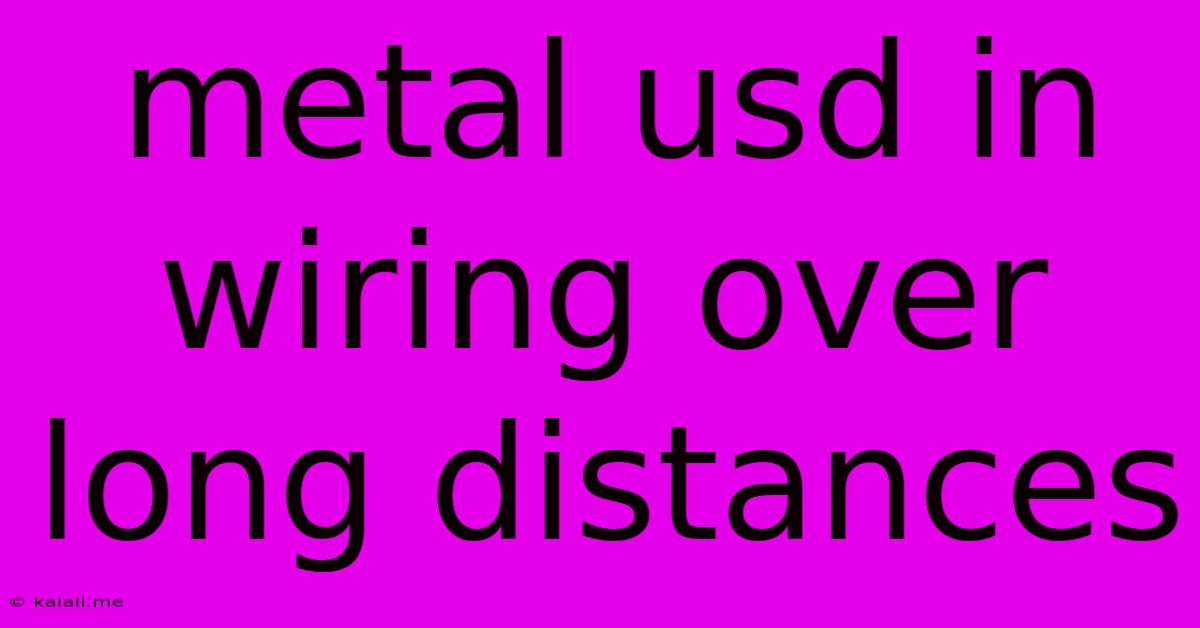Metal Usd In Wiring Over Long Distances
Kalali
May 31, 2025 · 3 min read

Table of Contents
Metal vs. USD in Long-Distance Wiring: A Comprehensive Comparison
Choosing the right wiring material for long-distance applications is crucial for ensuring reliable signal transmission and minimizing signal loss. This article delves into the critical differences between using metallic conductors and utilizing USD (presumably referring to a hypothetical or unconventional system, as USD typically denotes the United States Dollar) for long-distance wiring, focusing on their practical implications and advantages/disadvantages. We will examine factors like signal attenuation, cost, installation complexity, and environmental considerations.
Understanding Signal Attenuation in Long-Distance Wiring
Signal attenuation, the weakening of a signal over distance, is a primary concern in long-distance wiring. Metallic conductors, such as copper and fiber optic cables, are well-established for their ability to transmit signals over considerable distances with minimal loss, although the extent of this loss varies based on the conductor's material and the signal frequency. Copper wires, for instance, are susceptible to higher attenuation at higher frequencies. Fiber optic cables, on the other hand, offer significantly lower attenuation and higher bandwidth, making them ideal for long-distance data transmission.
If "USD" refers to a theoretical system for long-distance signal transmission, we must consider the fundamental challenges it would face. Any system competing with established technologies like copper and fiber optics must demonstrate superior performance in terms of signal integrity and data transfer rates. This would require addressing the potential issues of signal attenuation and interference, which are inherent in electrical signal transmission across long distances.
Metallic Conductors: Copper and Fiber Optics
Copper wiring, while relatively inexpensive, suffers from higher attenuation compared to fiber optics, especially at higher frequencies. This necessitates the use of repeaters or amplifiers at regular intervals along long-distance copper lines to boost the signal, increasing complexity and cost. However, copper's familiarity and existing infrastructure make it a practical choice for certain applications.
Fiber optic cables, on the other hand, transmit data as light pulses, resulting in significantly lower attenuation and higher bandwidth compared to copper. This allows for much longer transmission distances without the need for frequent signal amplification, making them the preferred choice for many long-distance applications, such as telecommunications and high-speed internet. However, fiber optic cabling is generally more expensive to install than copper wiring.
Hypothetical USD System: Challenges and Considerations
Assuming "USD" represents a novel long-distance wiring technology, its viability hinges on several crucial factors:
- Attenuation characteristics: The system must demonstrate significantly lower attenuation than existing metallic conductors, especially at high frequencies, to compete effectively.
- Bandwidth capacity: A high bandwidth is essential for supporting modern data transmission requirements. The USD system would need to offer superior bandwidth compared to current copper or fiber optic solutions.
- Cost-effectiveness: The overall cost, including materials, installation, and maintenance, should be competitive with established technologies.
- Scalability: The system needs to be scalable to accommodate future bandwidth demands and increasing transmission distances.
- Environmental impact: The manufacturing process and lifecycle environmental impact of the USD system need to be considered.
Conclusion: The Current Landscape and Future Possibilities
While metallic conductors, particularly fiber optics, currently dominate long-distance wiring applications, the exploration of alternative technologies is crucial for advancing communication infrastructure. Any hypothetical "USD" system would need to overcome significant hurdles regarding signal attenuation, cost, and overall performance to successfully challenge established methods. Future advancements may focus on developing new materials or transmission methods to further reduce signal attenuation and enhance data transmission capabilities over vast distances. However, until a system demonstrably outperforms existing solutions in terms of efficiency, cost, and reliability, copper and fiber optics remain the dominant players in long-distance wiring.
Latest Posts
Latest Posts
-
Best Pokemon Team In Pokemon Y
Jun 01, 2025
-
Can Dolls Come To Life And Kill
Jun 01, 2025
-
What To Use When Screw Does Not Tighten
Jun 01, 2025
-
Sed Expression 1 Char 1 Unknown Command
Jun 01, 2025
-
Other Users And Shared Mac Storage
Jun 01, 2025
Related Post
Thank you for visiting our website which covers about Metal Usd In Wiring Over Long Distances . We hope the information provided has been useful to you. Feel free to contact us if you have any questions or need further assistance. See you next time and don't miss to bookmark.